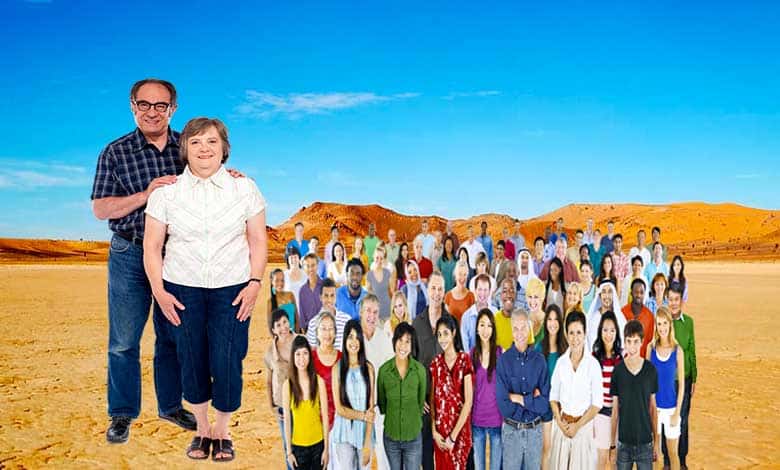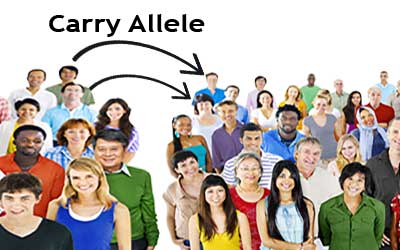
Hello, evolutionary explorers and biology buffs! Have you ever pondered how small groups of organisms can lead to the incredible diversity of life we see today? Well, you’re in for a treat! We’re diving deep into the world of genetics and evolution to explore the Founder Effect. This fascinating phenomenon occurs when a new population is established by a very small number of individuals, leading to unique genetic variations that set it apart from its original population.
We impact our lives, hunting, and habitat degradation. So, we lose most of a species, and we see this in white rhinos and many big cats. If you look at genetics, you see a clear sign that most genes are relatively diverse. But in genes that are only inherited from the seeds.
So those would be maternal genes. They have very low diversity. So, the pollen coming from the father from very long distances can bring in lots of genetic diversity. The seeds that can’t disperse very far mean only limited genetic diversity in the genome’s maternal portions.
Genetic drift is a mechanism of evolution responsible for random changes in a gene pool. It happens to all populations but has a much more visible and drastic effect on small populations. It’s driven by chance and not selection. So evolutionary fitness doesn’t matter here. It’s all random, and natural selection doesn’t come into play when looking at genetic drift.
Grab your explorer’s hat and join us on an adventure through time and genetics as we uncover the secrets of how the Founder Effect shapes our planet’s biodiversity. Let’s set sail on this voyage of discovery!
What Is Founder Effect?
The founder effect happens through emigration, which is colonizing a new location. Whenever a group moves from one place to a new location, it’s known as immigration. Specific habitats may not be continuous in the environment. So, for example, coral reefs may be separated by open seafloor without corals. Mountains, rivers, or oceans can separate forested regions.
Therefore, populations may be restricted to certain geographic areas. If a population member often expands into a new region, a limited number of individuals do this, sometimes only one. So, the representatives who reach the island are a small subset of the original population. Or those who cross the river or the mountain range.
It may be a small subset of the original population. Therefore, the new population’s characteristics will be determined by the features present in that population’s founders. It is known as the founder effect. So, an overall allele frequency change can occur if a small population finds a new larger population whose alleles will now be determined by the subset of alleles present in the founders.

Explanation with an example: In South Africa, the population is named after the African people. Few Dutch people found that population. They went there to South Africa and began colonizing there at the very beginning. There are only 20 people who go there and start the population and colonize there slowly. Thousands of people living there in South Africa originated from the original twenty people-founded population.
Now that population was founded very early with only 20 people. Tiny population changes have been constructed since allele frequency has many differences. At that time, though, among those 20 people, many of them have a disease known as Huntington’s disease.
As they have Huntington’s disease in most people in that 20-found population throughout the year, the rate of Huntington’s disease is very high in South Africa. The percentage of Huntington’s disease becomes very high. The reason for that is the founding population. Many of the founding population already had that this was earlier. So, it is known as the founder effect. Because, at that early time, some of the alleles carried Huntington’s disease.
Some of these alleles remain changed, and their population and frequency are also changing. It might increase over time. So, individuals in that particular population in South Africa now get those diseases quite often.
Let’s think about a small island and a small group of seven people. 43% have an unattractive condition that causes them to be bald. The percentage of bald people on the mainland is much lower, only about 10%.
The small population of humans arrives on the secluded island far from any mainland. Remember that this group accurately represents the percentage of people in the normal population with this hairless condition.
The small group of founders arrives on the island and begins to know one another. The small number of humans procreate until their population grows to a number supported by the island’s conditions. As procreation continues, notice the increasingly high number of bald people.
After another population survey, there’s a much higher percentage of all island people. It is a result of the founder effect. If descendants do, the island founders had a much higher percentage of people with the genetic condition. Suddenly, a natural disaster comes and wipes out the entire population except for a few survivors.
As rubble is washed away, life begins to flourish again on the island. The survivors begin to rebuild their population with an even higher percentage of people than before. It is a result of the bottleneck. There was already a high percentage of the condition on the island before the disaster. When nearly all the population is wiped out, the survivor’s genetics are passed on to their descendants. Also, they represent an even higher percentage of people than before the disaster.
At this point, we have a small population inhabiting our fictional island. Due to the absence of natural disasters, the population exists freely. However, the factor of randomness has yet to be examined. As chance happens gradually, more and more people with air survive. Subsequently, reproduce on the island. Due to the small population, the allele frequencies slowly change over time.
We have a mother group. A portion of this group essentially branches off and goes and creates a new colony elsewhere. Their genetic makeup may differ from the mother group or the original group. There’s a lot of variability in genetics, and there are a lot of individuals. A portion of this mother group branches off. So, this is what humans do. In history, we’ve seen Europeans, a certain number of them, branch off and colonize other areas in the world.
In this case, humans may have alleles when they colonize another area. They may possess alleles in their genetics that could negatively impact them because they were originally living. Their population was originally living in a mother group. Also, This group was large and had a lot of genetic variabilities. Their genetics may have almost been hidden!
Suppose you have a gene that needs to be homozygous to be expressed. But you’re in a genetically variable group. Then, technically, you will see a lot of heterozygosity. There’s a lot of gene variability, so it won’t be expressed. You won’t see the genetic defect or the illness that gene or allele may entail.
Founder Effect In Humans
In humans, the Founder Effect has been observed in several isolated populations and has profound implications for genetic diversity, the prevalence of certain genetic traits, and susceptibility to genetic disorders.
Examples of the Founder Effect in Humans
The Amish of Pennsylvania: This population, originating from a small group of founders who emigrated from Europe in the 18th century, exhibits higher rates of certain genetic disorders, such as Ellis-van Creveld syndrome (a rare form of dwarfism) and polydactyly (extra fingers or toes). These conditions are much more common in the Amish population than the general population, likely due to the Founder Effect combined with the community’s relatively closed society and intermarriage practices.
The Finnish Disease Heritage: Finland has several rare genetic disorders more prevalent than elsewhere, known collectively as the Finnish Disease Heritage. These include conditions such as Congenital Nephrotic Syndrome of the Finnish type. The increased prevalence of these diseases is attributed to the Founder Effect, as a relatively small number of individuals historically populated Finland, and their genetic traits have been passed down through generations.
French Canadians of Quebec: This population shows a higher incidence of certain genetic disorders, such as Tay-Sachs disease and cystic fibrosis, compared to other populations. The Founder Effect is significant here due to the small group of French settlers who initially colonized the area in the 17th century and their relative isolation.
Afrikaners in South Africa: Huntington’s disease and other genetic conditions have a higher prevalence among the Afrikaner population of South Africa. This is attributed to the small initial population of Dutch settlers in the 17th century and the limited influx of new genes into the population over time.
Founder Effect Vs Bottleneck
The Founder Effect and the Genetic Bottleneck Effect are both evolutionary phenomena that lead to a reduction in genetic diversity within a population. Despite their similarities, they originate from different circumstances and have distinct implications for the genetic makeup of populations. Understanding the nuances between them is crucial in evolutionary biology, conservation genetics, and the study of population dynamics.
Key Differences
Initiation: The Founder Effect is initiated by a few individuals’ establishment of a new population, whereas the Bottleneck Effect is caused by a drastic reduction in the size of an existing population due to external pressures.
Genetic Diversity: Both effects reduce genetic diversity, but the mechanisms and outcomes vary. The genetic makeup of the initial small group of individuals shapes the Founder Effect. At the same time, the Bottleneck Effect is influenced by the random survival of individuals regardless of their genetic traits.
Long-Term Implications: Both phenomena have long-term implications for the population’s genetic health, including increased susceptibility to genetic diseases and reduced adaptability to environmental changes. However, the context and historical dynamics leading to these situations differ between the two effects.
Understanding these concepts is critical in fields like conservation biology, where strategies to preserve endangered species must consider populations’ genetic health and diversity. It’s also relevant in studying the migration patterns and history of human populations, as both effects have significantly shaped the genetic landscape of human societies worldwide.
We’ve explored genetics and evolution, discovering how small groups of individuals can give rise to new populations with unique genetic identities. It’s a testament to the power of genetics and the unpredictability of evolution, showcasing the beauty and complexity of life on Earth. We hope this exploration has ignited a spark of curiosity in you, enriching your understanding of the natural world and its evolutionary wonders.
Thank you for joining us on this enlightening adventure. Until our next foray into the marvels of biology, keep pondering the mysteries of life and the myriad ways it evolves. Keep exploring, questioning, and, most importantly, marveling at the wonders of the natural world around us!
More Articles:
How Do Neurotransmitters Work – By Types & Importance
What Is The Mechanism Of Evolution?
What Is Evolutionary Fitness & Example
Evolution Of Life On Earth Timeline
What Will Humans Look Like In 100 Years?
How Humans Lost Their Fur? – Human Hair Evolution
What Does Dopamine Do For The Brain? – Function & Work
References:
Provine. “Ernst Mayr: Genetics and speciation.” Genetics.
Templeton, A. R. “The theory of speciation via the founder principle.” Genetics.
Hartwell, Leland; Hood, Leroy. Genetics: From Genes to Genomes.
Raven, Peter, Susan. Biology of Plants. W H Freeman and Company.
